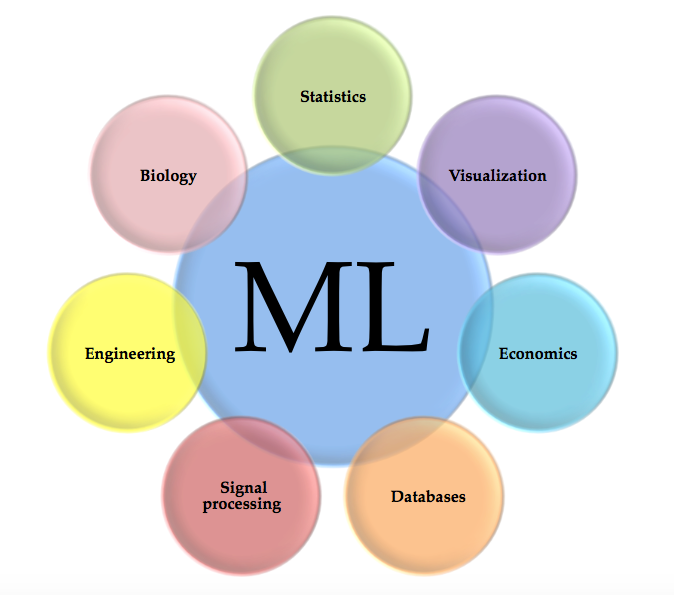Siri. Alexa. Google Home. Netflix recommendations. Facebook’s “People you may know”. Self-driving cars.
All powered by machine learning.
The world is quietly being reshaped by machine learning as people unknowingly use it every day. Machine learning is a tool in artificial intelligence that stands at the intersection between many crafts. It provides computers the ability to learn from data on their own, detect hidden patterns, and adjust when exposed to new information. It can be used to classify or predict to help people optimize and take the best course of action.

The general process of machine learning is pretty straightforward. I first collect data. This data could be a person’s height, weight, or income. It could be the amount of times they clicked on a Twitter link or searched “Mother Theresa” on Google. This data is extremely valuable to organizations as it is what drives their decisions. I then feed this data into my machine learning algorithm and my algorithm “learns” from it. It builds a model that remembers all of the patterns and infers new ones. Now, if I feed it a new piece of data, it can then classify or predict new information based off of our newly built model. It can do this better than humans can.
To be more concrete, let me paint a picture.
I’m a new startup and I want to know who to market my new hair loss product to. I collect data of some customers who have shopped at Walmart. This data includes net income, education, health records, search history, and whether they have kids or not.
Now, I could easily assume that everyone who is bald would want to buy it and everyone who isn’t, wouldn’t. But if I’m a new startup, and I care deeply about my bottom line, I’d want to increase my margins as much as I could. Every penny matters. Not everyone who is bald wants their hair back. And the ones who do, might not want my product because they are worried about the chemicals.
So the best thing I could do, to be as optimal as possible and make the most money, would be to market it to exactly every single person who would buy it.
How could I possibly know exactly who would buy it? With the data we have collected.
Let’s say the data I have collected is from 2008-2016. It has a full profile on the two types of people that have gone into Walmart. People who have bought my hair loss product, and the people who haven’t. These are known as labels. I then feed this data into a machine learning algorithm and it analyzes and infers all sorts of patterns with the information I have given it (net income, education, health record, etc.).
After some time, the algorithm is done processing and has built a model that has seen 8 years of people who have and haven’t bought my product. With this model, I can now predict the exact type of person that will buy my goods, and proceed to market it to just those type of people. The traits of the people who purchased the product might have not been obvious to humans and consequently overlooked.
The machine learning algorithm could have showed me that people with normal blood pressure, 2-4 kids, no college education, an income below $90,000 and have googled “hair loss” are 95% likely to buy it, regardless of whether they are bald or not. Why are those traits correlated with people who buy my product? We don’t know for sure. That’s the black box in machine learning, sometimes it doesn’t explain its reasoning.
So, my startup could easily increase its margins by marketing to people with those exact traits, instead of just strictly bald people.
But machine Learning isn’t just used in startups. The applications of machine learning from academia and industry is leading to advancements across many fields of human endeavor.
Medical companies use it to diagnose illnesses and to see what the best treatment could be.
Politicians use it to figure out exactly where to campaign and place their ads at.
In law enforcement, it can be used to help predict the behavior of people to prevent negative events from happening.
The financial industry uses it for insights that can identify investment and trading opportunities. It is also used to make credit scoring and fraud detection more efficient.
Marketing and sales use it to analyze data on customers’ search history and past purchases for targeted advertising schemes or to build personalized products.
There are a plethora of other groundbreaking applications. All of it, powered by machine learning.
It is powerful tool that must be handled with care as its potential future applications are almost unlimited. Without a doubt, machine learning will help usher in a new technological revolution. With all of its transformative powers, we no longer need to perform grunt work or complicated tasks. Instead, we build systems that teach themselves how to efficiently do it. This means many jobs will become obsolete in the near future, possibly widening the gap between the rich and poor. Ethical practices must be enforced and we must accommodate for that scenario. This is not science fiction. This is not a fad. The technology is rapidly growing and barring a nuclear war or rapture, machine learning will take over many aspects of our lives. Only time will tell if this is a good or bad thing. Regardless, it is a burgeoning field that’s drawing top talent from all over the world. Now is the time to jump in.
